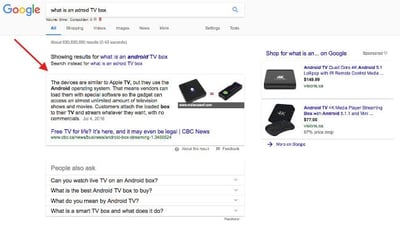Editor's Note: This post was originally published on June 8, 2018, and updated with additional content on January 2022.
It is undeniable that On-SERP SEO is incredibly important for any digital marketing strategy. In 2024 and beyond, digital marketers and companies that embrace digital marketing strategies need to be well-versed in changing what they care about. Oh, and caring about many things at once comes standard with living in the digital world. And for good measure, let's keep an eye on the future with the intent to figure out the next pivot before anybody else – and boldly act on it.
If that all feels like a tall ask - we get it! In a dynamic industry like digital marketing, it's easy to feel like you're playing a never-ending game of whack-a-mole with new tools, information, and updates.
That's why I've accepted that SEO optimization is a long-term mission. With all the tinkering that Google does on SERPs (especially mobile SERPs), I know that what works today for our website's SEO won't necessarily work tomorrow. But just because SEO optimization has turned into a marathon instead of a sprint, that doesn't mean that we can't try to earn that gold medal!
What is On-SERP SEO?
Before you can snag the answer box of your dreams, you first need to know what On-SERP SEO is (and if you don't know, that's totally fine).
On-SERP SEO is the optimization of any and all content on SERPs that you can either control or influence in some way. Traditionally, meta titles and meta descriptions were the main (and only!?) content that SEOs and content marketers could control on SERPs, but that changed when Google introduced featured snippets, which are:
Featured snippets are organic search results that Google doctors up to look pretty, and then places them in the most prominent position on the SERPs – yes, above the #1 results!
Here is the featured snippet on the SERP for the query, "What is an Android TV box?":

For this particular result (at least on Google Canada), the paragraph answer box is owned by CBC, the Canadian Broadcasting Corporation. Start Googling things, and if you haven't already noticed, many SERPs will include a featured snippet at the top of the page, especially if your queries are questions.
This is a great rundown of the different types of featured snippets and other on-SERP SEO content.
Why is On-SERP SEO Important For Your Customer Journey?
There are a number of reasons why On-SERP SEO is important. On a basic level, we can use the Android TV box example above to highlight why a business would covet the featured snippet the CBC currently has.
The CBC article explains what an Android TV box is and how it allows users to "cut the cord" and essentially watch all the TV shows and movies they want—for free. It discusses the legality of the apps that allow users to stream for free and even links to some websites that sell preloaded TV boxes.
For a large media corporation like CBC, readership, traffic, and awareness are the bread and butter of their business, so the more featured snippets they can attain, the better. In this specific case, they could likely earn some affiliate commissions with a featured snippet for a query with tens of thousands of searches per month, according to keyword data. For whatever it's worth, CBC isn't using affiliate links, but it's easy to see why for content-driven affiliate sites, featured snippets are extremely valuable.
There is another, less obvious reason why On-SERP SEO is becoming a vital component of core SEO—if more and more searches are ending on the actual Google SERPs, then On-SERP SEO is critical because, at least right now, it's difficult to discern what the goal of featured snippets should be, if not to generate click-throughs. As is usually the case in the digital world, the marketers and companies who figure out how to crack these tough questions are the big winners.
How to Optimize Your Content for SERPs
Ah, now to answer the question you're all wondering about: how do you optimize your content in order to attain a featured snippet on Google's search engine results page?
Here's the short answer to how you win a featured snippet on Google's search results pages:
- Do keyword research to develop a shortlist of specific questions that
- a) you can answer and,
- b) you can rank for
- Rank on the first page for one of these search query questions
- Optimize the content of your web page to very specifically answer the question
So now that we have a better understanding of the 'how', let's get into some tactics that you can start leveraging today for your business.
7 Actionable Tactics to Optimize Your Website in Competitive SERPs
Various actions can be taken to optimize a website in competitive search engine results pages (SERPs). Here are seven actionable tactics.
1. Optimize Your Top 10 Ranking Keywords to Win a Featured Snippet
A featured snippet is a brief excerpt from a webpage that appears on a SERP to answer a user's question so they do not have to search further. The most general forms of featured snippets are tables, text, lists, and videos.
To win a featured snippet, see which keywords on your current organic rankings display in a featured snippet and use the top ten to optimize your website.
2. Optimize for Google Sitelinks
Sitelinks display your website's most important pages directly within your search results. To optimize for Google site links, create a clear navigational structure with strong internal links to core pages.
3. Add Schema Markup When Appropriate
Schema markup is code that improves the way search engines read and represent a page on SERPs. It helps search engines understand your content. Use schema markup for Google, Bing, Yandex, and Yahoo!. Add schema markup when appropriate.
4. Use & Optimize Google My Business
Google My Business is a free directory that businesses and organizations use to increase their online presence. This is a great tool for small businesses that want to increase their visibility in their area.
Add all the required information and verify the listing with Google. It is helpful to add question-and-answer (Q&A) information and reviews. A business will also appear on Google Maps through Google My Business.
5. Run Branded PPC Ads
Your brand is your business. Always run branded pay-per-click (PPC) advertisements so anyone searching for your brand name can find you. It improves the chance of an increased click-through rate (CTR).
6. Optimize Social Media Channels to Appear in Knowledge Panels
Google knowledge panels display information about a business in one condensed spot. Optimize social media channels and verify them with Google. It increases the chances of your social media channels appearing on a SERP knowledge panel.
7. Optimize Images to Appear in SERPs & Featured Snippets
Google wants you to provide a great user experience to boost your content's visibility in SERPs and featured snippets. To optimize images, do the following:
- Make the visual content relevant to the page topic.
- Place images near the relevant text whenever possible.
- Do not embed important text inside images.
- Create informative, quality page content.
- Create device-friendly sites.
- Create a good URL structure for images.
On-SERP Elements We Can Optimize For
SERPs are more competitive than ever, and there are now additional features to optimize for than traditional organic results.
1. Video carousels
Google states that eighty percent of people surveyed switch between online search and YouTube videos when researching products to buy. A video carousel is an interactive box with videos related to a search query. In mobile search results, the video carousel fills most of the screen.
2. Image results
Google image results are a single row of images pulled from top-ranking results related to a search query. To appear in Google search results, Google advises uploading high-quality images and including descriptive text.
3. Recipe carousels
Recipe carousels are like video carousels, but all content is from food-related queries. Google requires structured data such as cooking and preparation time, nutritional information, and viewer ratings for a recipe to appear on a carousel.
4. Local packs
Local packs highlight nearby businesses when Google searches are done for goods and services in a specific area. Local pack information is drawn from Google My Business.
5. Interesting finds
Interesting finds are an organic search feature shown on mobile search engine results pages (SERPs).
6. Google Shopping results
Google Shopping results appear on SERPS when a searcher directly states or implies they want to buy a product or service. The aim is to make it easy for users to research a purchase and connect with the seller.
SERP SEO Tools That Can Be Used to Study SERP Features or Your Positioning
With so much information to consider, it is essential to use a tool to study search engine result page (SERP) features and your positioning within them. We suggest some tools.
Semrush Position Tracking
The Semrush Position Tracking tool helps you track your SEO and PPC efforts, see how competitors rank in search results, and identify opportunities to reach your audience based on market trends. It can also track your position and help you choose domains and keywords to monitor.
Moz Keyword Explorer
Moz Keyword Explorer gives a SERP analysis breakdown of links and social data on each ranking position. So you can understand why pages rank where they do. You can also discover, prioritize, and build lists of high-quality keywords.
Ahrefs Rank Tracker
Ahrefs Rank Tracker lets you monitor your Google rankings on desktop and mobile across 170 countries. It provides data on the following SERP features: featured snippets, sitelinks, top stories, image packs, thumbnails, top ads, bottom ads, shopping results, knowledge cards, knowledge panels, videos, a tweet box, and people also ask.
Other SERP SEO Tools
There is an SEO tool for every user level, from starters to the experienced. Search Engine Journal (SEJ) highlights some paid SEO tools worth considering. They include:
- Majestic lets you see where links originate. You can compare links and determine the total weight of each backlink.
- Spyfu is a search analysis tool for SEO keyword searches. It lets you search for a domain and see every place it has shown up on Google. It also has a SERP checker.
- Mangools has a complete set of basic tools for beginners and is easy to use.
SERP FAQs
What is SERP vs SEO?
Search Engine Results Pages (SERP) are the pages you see when you use search engines such as Google, DuckDuckGo, and others.
Search Engine Optimization (SEO) is a set of practices using keywords, hyperlinks, high-quality content, and more to improve the positioning of a website and its contents on SERP.
What is a SERP position?
A SERP position is defined by where a website or content appears on the first search engine results page. A well-optimized website will be at the top of the organic search results.
What is SERP marketing?
SERP marketing uses all the tools available to ensure a website or content is optimally visible on a SERP. These tools include keywords, sitelinks, quality content, social media activity, accurate and descriptive image and video titles, reviews, question-and-answer pages, quality images, and more.
What are SERP features?
SERP features are any results on a Google search engine results page (SERP) that is not the standard organic (blue line) result.
What is the Importance of tracking SERPs?
Tracking search engine results pages is essential for measuring the effectiveness of SEO strategies and understanding how your website performs against competitors. It helps improve organic traffic and click-through rates by optimizing content based on performance insights. Additionally, tracking SERPs allows you to quickly adapt to algorithm changes and capitalize on SERP features like rich snippets and local packs to enhance visibility.
What are the most common SERP features?
The most common SERP features are featured snippets; people also ask for image and video carousels and local packs.
- Featured snippets are blurbs taken directly from organic results that answer a question or clarify an idea. They appear at the top of the SERP.
- People Also ask/related questions, highlight, or link to other questions related to a specific search. People Also Ask is given high visibility on SERP.
- Image and video carousels highlight the most relevant videos and images related to a search.
- Local packs help searchers find businesses, places, etc., in their local community. It usually includes Google My Business listing information and a map sourced from Google Maps.
Which SERP feature was used on Google first?
Google's first SERP feature was AdWords, a pay-per-click advertising product launched in 2000. Today, Google AdWords is known as Google Ads.
How many SERP features exist today?
SERP features continue to grow as search engine users' needs are identified and provided for. The current group of SERP features includes:
- Featured snippets
- Google Ads
- Google shopping results
- Image Carousel
- Interesting Finds
- Knowledge card
- Knowledge panel
- Local packs
- Local teaser
- News
- People also ask/related questions
- Related searches
- Recipe carousels
- Tweets
- Video carousels.
In Conclusion
Simple, right? If only!
Look, nobody said this was going to be easy. The great Dr. Pete has been writing on this topic for years now, and his older articles are still some of the best content there is on the subject (start with this article here, continue with this post here, and wrap things up here) – quite frankly because we just don't have any more of an idea of what works. Of course, tools like Moz or SEMrush will make your life a lot easier if you're planning on doing this alone, or you could always get in touch with us – we'd love to help you improve your On-SERP SEO!
At the end of the day, keeping up with On-SERP SEO trends and perhaps attempting to win a featured snippet or two likely puts you way ahead of your competition. And if you can become an expert at On-SERP SEO and make getting featured snippets like second nature, you'll be reaping huge rewards in the future. Contact our expert digital marketing team at WSI to learn more about the importance of On-SERP SEO.






